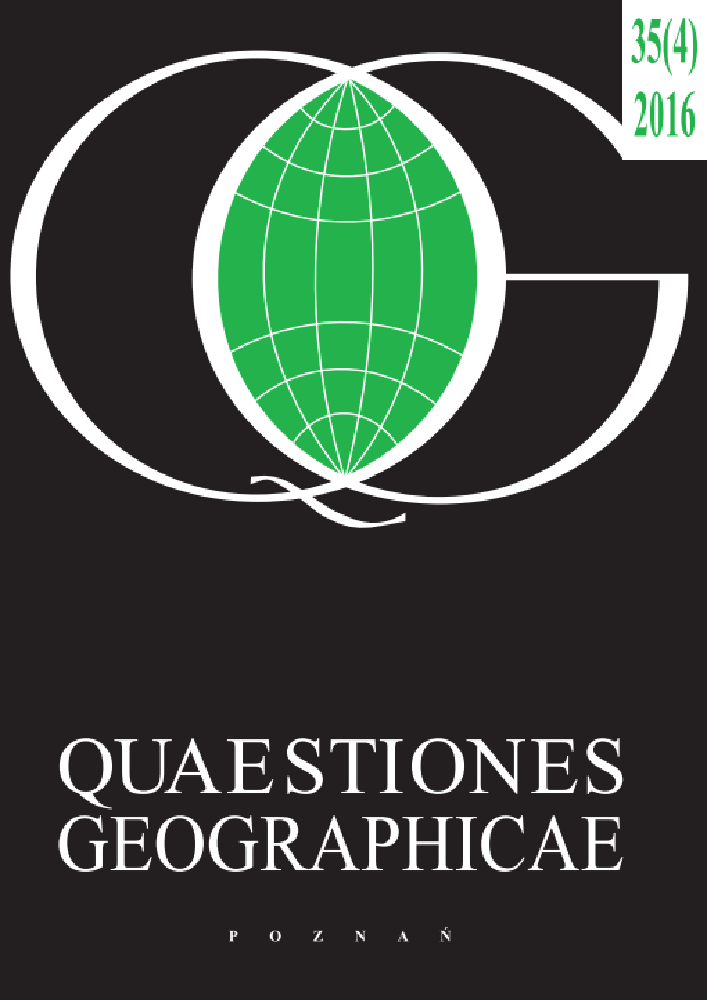Abstract
The entry into force of the Agreement between the Republic of Poland and the Russian Federation on visa-free movement in 2012 caused an increase in border permeability, and hence a sudden increase in border crossings. The border which used to divide the neighbouring states started linking them instead. Crossing the border became part of the everyday life of local communities. Actors on both sides benefited from the commercial services of the other country. For Kaliningrad citizens, border-crossing points became gates to Europe, and for Poles, a resource improving the quality of life via petty trade. The aim of this article is to compare two border cities: Braniewo, a town located in the immediate vicinity of the border-crossing point, and Tri City, which has become a new border centre after the introduction of small border traffic. Two viewpoints on the effect of local border traffic are presented. The first is the perspective of a typical border city. The other is that of the effect of an increase in border permeability on a major urban centre – Tri-City.
References
Agreement on a visa-free travel zone between Poland and Russia, 2012 (Official Gazette 2012, position 814).
Cross-border traffic at the Polish-Russian border, 2015. Border Guards, unpublished statistics.
Domaniewski S., Studzińska D., 2016. The small border traffic zone between Poland and the Kaliningrad region (Russia): The impact of a local visa-free border regime. Geopolitics 21(3): 538–555.
Donnan H., Wilson T.M., 1999. Borders: Frontiers of identity, nation and state. Oxford-New York, Berg.
Dudzińska K., Dyner A., 2013. Small border traffic with Kaliningrad: Challenges, opportunities, threats. PISM Policy Paper 29 (77): 1–7.
Hanson G.H., 1998. Regional adjustment to trade liberalization. Regional Science and Urban Economics 28 (4): 419–444.
Heffner K., 2010 . Granica – rozwój instytucji (Border – the development of institutions). In: Grochalski S.M. (ed.), Ewolucja instytucji granicy we współczesnej Europie. Wydawnictwo Uniwersytetu Opolskiego, Opole: 77–100.
Komornicki T., 1999. Granice Polski. Analiza zmian przenikalności w latach 1990–1996 (Polish borders. An analysis of changes in their permeability in the years 1990–1996).Geopolitical Studies 5, PAN IGiPZ, Warszawa.
Opioła W., Trzcielińska-Polus A., 2013. Fenomen pograniczy (Phenomenon of borderlands). Pogranicze. Polish Borderlands Studies 1: 6–11.
Poles in Kaliningrad, 2015. http://wiadomosci.wp.pl/kat,1019385,title,Zaatakowali-Polakow-w-obwodzie-kaliningradzkim-Zadali-pieniedzy-za-ochrone, wid, 17381700, wiadomosc. html?ticaid=1154bf.
Protest in Braniewo, 2015. Online: http://www.tvp.info/16971069/gornicy-w-braniewie-blokuja-transporty-wegla-z-rosji-zadaja-od-kopacz-odpowiedzi-na-postulaty- w-jej-expos (accessed 10 June 2015).
Russians’ opinion about Gdańsk, 2015. Gdańsk City Hall, Department of Socio-Economic Analysis, unpublished statistics.
Sohn C., 2014. Modelling cross-border integration: The role of borders as a resource. Geopolitics 19(3): 587–608.
Spierings B., Van der Velde M.R., 2008. Shopping, borders and unfamiliarity: Consumer mobility in Europe. Tijdschrift voor economische en sociale geografie 99(4): 497–505.
Studzińska D., Nowicka K., 2014. Mały ruch graniczny z perspektywy władz lokalnych i mieszkańców. Przykład granicy polsko-rosyjskiej (Local border traffic from the point of view of inhabitants and local authorities. The case of the Polish-Russian border). Prace i Studia Geograficzne 54: 275–288.
Where Poles and Russians meet, ideals and profits clash, 2015. Online:http://www.nytimes.com/ 2015/04/25/world/europe/where-poles-and-russians-meet-ideals-andprofits-clash.html?_r=0 (accessed 10 June 2015).
License
© Faculty of Geographical and Geological Sciences, Adam Mickiewicz UniversityThis work is licensed under the Creative Commons Attribution-NonCommercial-NoDerivatives 4.0 License.

